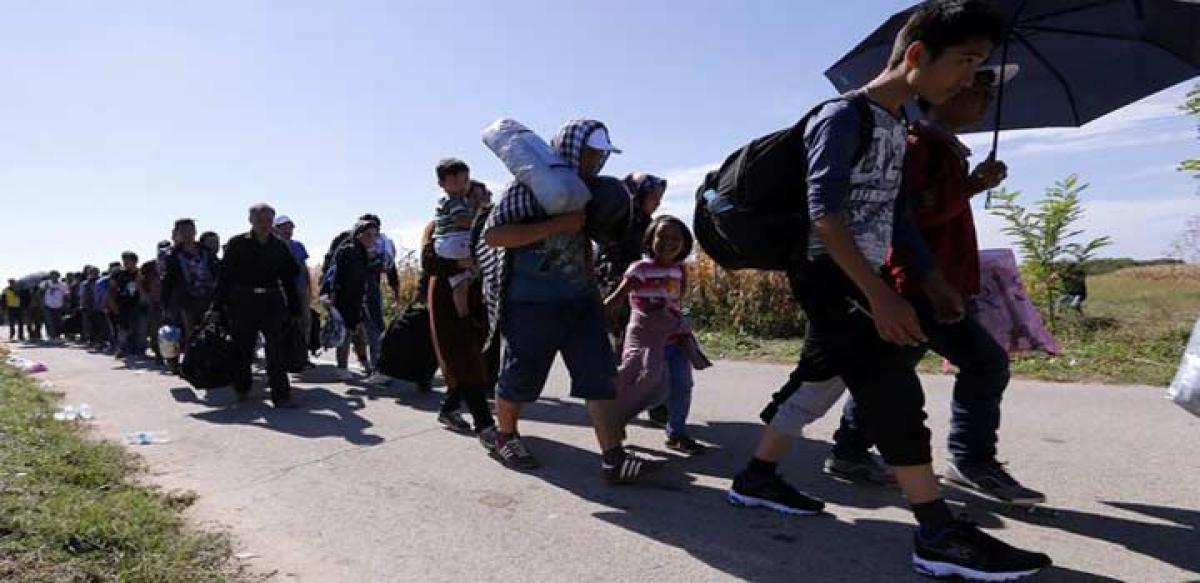Live
- ‘Bhool Bhulaiyaa 3’ Teaser: Kartik Aaryan’s Film Sets the Stage for Spooky Fun
- District Collector Adarsh Surabhi said that every citizen of Telangana should work for the realization of Konda Laxman Bapuji's ambitions.
- Is Jr NTR's Devara Part 1 Breaking Box Office Records with Rs 140 Crore Opening?
- Rs 850 crore HPC systems to bolster weather, climate research in India
- India likely to add 35-40 MT crude oil refining capacity by FY30
- ADB approves $37.5 million grant to Nauru
- World Tourism Day: Check the video that portrays rich heritage and tourist spots in Sri Satya Sai district
- CERT-In Warns Google Chrome Users of High Risk of Hacking – How to Protect Your System
- World Tourism Day 2024: Bridging Cultures and Fostering Global Understanding
- Flipkart Big Billion Days Sale: Buy iPhone 15 Pro for Under Rs 60,000
Just In

Dealing with migrant crisis. We have been here before. Hundreds of thousands of people fleeing in rickety boats, many of whom perish at sea as regional governments avoid search and rescue efforts in fear of their “pull factor.”
Faced with rising and unpredictable numbers of asylum seekers arriving directly at their door, most governments in the rich world have come to view resettlement as an avoidable burden rather than a useful tool of refugee protection
We have been here before. Hundreds of thousands of people fleeing in rickety boats, many of whom perish at sea as regional governments avoid search and rescue efforts in fear of their “pull factor.” Conditions at arrival made unwelcoming in order to deter others from attempting the journey. Still people continue to come.

In the two decades following the United States’ withdrawal from Vietnam in 1975, three million people fled the communist regimes of Vietnam, Cambodia and Laos. More than one million were boat people. A different sea and a different time, but the Indochinese refugee crisis has lessons to offer for today’s Syrian exodus.
Refugees are crossing the Mediterranean in dinghies, fishing boats and even steel-hulled ships, and struggling through southern and eastern Europe on foot, bicycles, buses and trains. They follow the same migration routes as asylum seekers from other nasty parts of the world, as well as economic migrants from sub-Saharan Africa.
According to the UN Refugee Agency, UNHCR, Syrian refugees account for 53 per cent of the nearly 400,000 illegal arrivals by sea to Europe so far in 2015. The Indochinese refugee crisis was resolved in great part through resettlement, agreed to and executed by a broad coalition of countries.
Like today, it took media attention on the countless tragedies at sea – coupled with serious political backlash and humanitarian crisis in host states such as Malaysia, Thailand and Indonesia – before governments overcame their urge to pass the buck and look away. There are many modern-day examples of large-scale refugee resettlement.
Hungarians fleeing after the 1956 uprising, and Kosovo-Albanians “ethnically cleansed” during the 1999 Kosovo war, benefitted from swift, organised resettlement of a significant proportion of the refugees in order to alleviate the humanitarian and security concerns of countries of first asylum. Between April and June 1999, NATO airlifted 86,783 Kosovo Albanians to 30 different countries, mostly in Europe and North America.
But times have changed. Only a tiny fraction of the world’s refugees today are resettled, while vast refugee populations languish for years and decades in refugee camps, such as the Dadaab settlements for Somali refugees in Kenya, and Zaatari, home to around 80,000 Syrian refugees in Jordan.
The resettlement of a relatively small, but significant proportion of Syrian refugees would alleviate the chaotic scenes played out across Europe. It would help stabilise and support Turkey, Lebanon and Jordan, all creaking under the pressure of the refugee influx. Over 90 per cent refugees have gone no further than just across the border.
Turkey hosts 1.9 million refugees, Lebanon 1.1 million - a quarter of the country’s population - and Jordan is home to 6,30,000 Syrians. The war is now in its fifth year. There are many more refugees, they are less welcome in their host states, those refugees who had savings have depleted them, and there is less humanitarian aid available per refugee in need.
The UN has received 37 per cent of the funds needed for the 2015 humanitarian programme for Syria’s displaced. The World Food Programme just announced to 2,29,000 refugees in Jordan that they would no longer receive food vouchers due to funding cuts. At least 7,00,000 Syrian refugee children are going without an education, according to the UNHCR.
But there is no safe and legal way for a Syrian refugee to travel to Europe – or to any other part of the world, for that matter. They have to resort to the perilous aid of people smugglers and, as a result, are transformed from refugees to “illegal immigrants.”
By Anne Hammerstad

© 2024 Hyderabad Media House Limited/The Hans India. All rights reserved. Powered by hocalwire.com







